
The Spider is an American pulp-magazine hero of the 1930s and 1940s. The character was created by publisher Harry Steeger and written by a variety of authors for 118 monthly issues of The Spider from 1933 to 1943. The Spider sold well during the 1930s, and copies are valued by modern pulp magazine collectors. Pulp magazine historian Ed Hulse has stated "Today, hero-pulp fans value The Spider more than any single-character magazine except for The Shadow and Doc Savage."
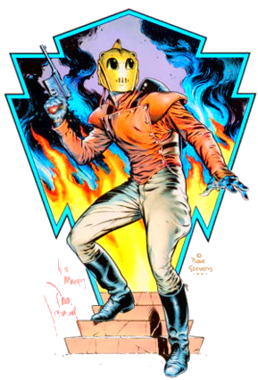
The Rocketeer is a fictional American comic book character, created by writer/artist Dave Stevens, the character first appeared in 1982 and is an homage to the Saturday matinee serial heroes from the 1930s through the 1950s.
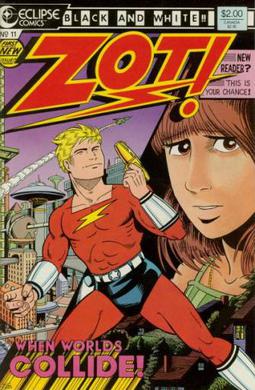
Zot! is a comic book created by Scott McCloud in 1984 and published by Eclipse Comics until 1990 as a lighthearted alternative to the darker and more violent comics that dominated the industry during that period. There were a total of 36 issues, with the first ten in color and the remainder in black and white.

Airboy is a fictional Golden Age aviator hero of an American comic book series initially published by Hillman Periodicals during the World War II, before ending his initial run in 1953. The hero was the costumed identity of crack pilot Davy Nelson II, and created by writers Charles Biro and Dick Wood with artist Al Camy.

Eclipse Comics was an American comic book publisher, one of several independent publishers during the 1980s and early 1990s. In 1978, it published the first graphic novel intended for the newly created comic book specialty store market. It was one of the first to offer royalties and creator ownership of rights.

Adolescent Radioactive Black Belt Hamsters is a creator-owned American funny-animal parody comic book series created by Don Chin. It was one of a number of parodies of Mirage Studios' hit Teenage Mutant Ninja Turtles series, itself a parody of popular eighties comics such as Frank Miller's Daredevil and Ronin; others included Naive Inter-Dimensional Commando Koalas and Pre-Teen Dirty-Gene Kung-Fu Kangaroos.

Aztec Ace is an American creator-owned science fiction comic book formerly published by Eclipse Comics. Created by writer Doug Moench, 15 issues appeared from 1984 to 1985. Amazing Heroes would describe the series as "a strange cross between Dr. Who and the Illuminati trilogy".

Scout is an American dystopian comic book series created and written by Timothy Truman, and first published by Eclipse Comics in 1985. The story stars a Native American Apache named Emanuel Santana. The setting of the series is a future United States that has become a Third World country.

Alien Encounters is an American science fiction anthology comic book published by FantaCo Enterprises and then Eclipse Comics. The comic debuted with FantaCo in 1981, and in 1985 was taken over by Eclipse.

The Masked Man is a fictional comic book crime-fighter created by B.C. Boyer and published by Eclipse Comics. His first appearance was in Eclipse #7, dated November 1982. The Masked Man is the alter ego of private eye Dick Carstairs, who takes on the identity of the Masked Man so that his friend Barney McAllister, a reporter, could grab headlines using tales of his crime-fighting adventures.
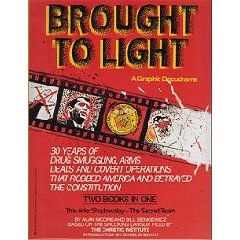
Brought to Light - subtitled Thirty Years of Drug Smuggling, Arms Deals, and Covert Action - is an anthology of two political graphic novels, published originally by Eclipse Comics in 1988.

Total Eclipse is an American comic book limited series in five prestige format parts published by Eclipse Comics in 1988 to 1989. A cross-company crossover commemorating the company's tenth anniversary, Total Eclipse was intended to bring all of the company's characters together, no matter how obscure or bizarre. These included Airboy and the Air Fighters, Strike! and Sgt. Strike, Prowlers Leo Kragg and Tim Kida, Aztec Ace, The Liberty Project, Miracleman, The New Wave and Beanish.

The New Wave was a superhero team comic book published between 1986 and 1987 by Eclipse Comics.

The Liberty Project is a creator owned American comic book series created by writer Kurt Busiek and artist James W. Fry. It was originally published by Eclipse Comics between 1987 and 1988, and concerned a group of super-powered criminals working for the U.S. government in exchange for the possibility of early parole.
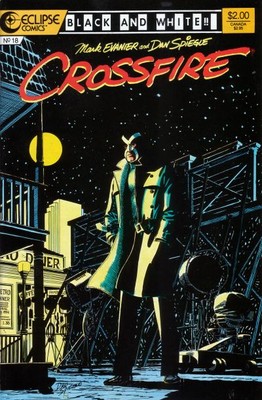
Crossfire is an American comic book series created by writer Mark Evanier and artist Dan Spiegle originally for Eclipse Comics. It was a spin-off from DNAgents, which was also written by Evanier. The series ran for 26 issues from May 1984 to October 1988.
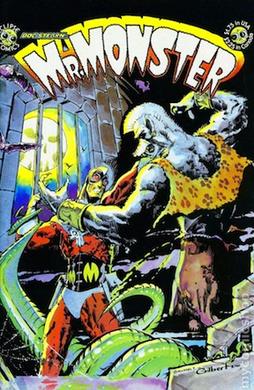
Doc Stearn...Mr. Monster is a comic book featuring a superhero created by Michael T. Gilbert, most recently published by Dark Horse Comics.

Strike! is an American creator-owned superhero comic book series created by writer Chuck Dixon and artist Tom Lyle, published by Eclipse Comics between 1987 and 1988. It concerns about a teenage boy who finds the power harness of Sgt. Strike, a hero that fought for the US in World War II before disappearing.
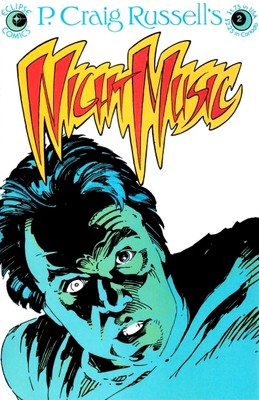
Night Music is an American comic book anthology created by artist P. Craig Russell, published by Eclipse Comics. It consists of comic adaptations of operas, novels, classical music and poems, and followed an irregular publishing model that changed formats according to the needs of the material.

California Girls is a creator-owned American comedy-romance comic series created by Trina Robbins. Published by Eclipse Comics between 1987 and 1988, the series chronicled the adventures of identical twin high school students Max and Mo in the fictional Californian town of Hollyhock. It was one of the few comics aimed at a primarily female audience published at the time.



















